The Best Texas Shade Plants – Pictures and Identification Guide
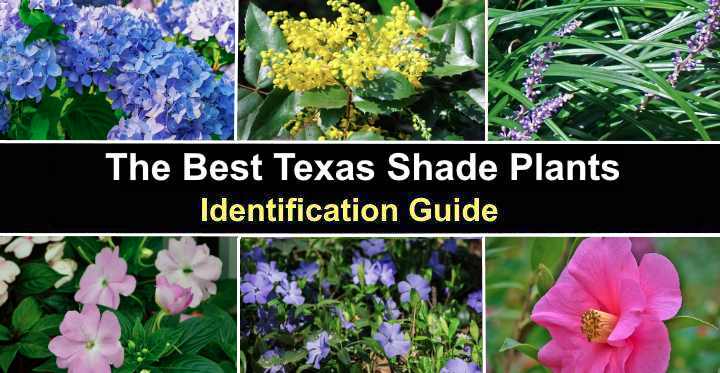
Choosing the best shade plants for Texas is a crucial part of gardening in the south. Shade plants in a Texas landscape should thrive, despite being in the shade for several hours a day. However, knowing which Texas flowering plants and shrubs are suitable for the shade can be challenging. After all, most plants, especially flowering ones, require some sunlight to thrive.
This article identifies the best shade plants for growing in the Lone Star State. You will find information about plants, shrubs, and flowers that require little sunshine to grow well. You will also get top tips on where to grow these Texas shade plants.
What Are Shade Plants?
Shade plants must be able to grow well in limited sunshine. Typically, plants for full shade or partial shade should thrive on one to three hours of sunlight. Some plants for light shade require dappled sunlight or a few hours of early morning sunshine. Additionally, some shrubs are suitable for full sun or partial shade.
How to Choose Shade Plants For Texas
Choosing Texas shade plants is necessary if you have a north-facing landscape or want to grow plants in the shadows of a fence, wall, or foundation line. In addition to the amount of sun exposure shade plants can tolerate, it’s vital to consider your growing zone, soil conditions, and maintenance requirements.
Here is a list of the USDA growing zones in Texas:
USDA Zone 6: Northern Texas, primarily the Panhandle. This zone includes Amarillo, Canyon, and Borger. Average minimum temperatures in winter are -10°F to 0°F.
USDA Zone 7: Central Texas and the state’s western region. Cities in this zone include El Paso and Lubbock. Average minimum winter temperatures are 0°F to 10°F.
USDA Zone 8: Central Texas, but the eastern part of the state. Cities include Dallas, San Antonio, Houston, and Austin. Average minimum winter temperatures are 10°F to 20°F.
USDA Zone 9: Southern tip of Texas from San Antonio to the Gulf Coast. Cities in this zone include Corpus Christi, McAllen, and Laredo. Average minimum winter temperatures are 20°F to 30°F.
Shade Plants in Texas (With Pictures) — Identification
Let’s look in detail at the best plants that thrive in shaded areas or grow in the shadows of tall trees, shrubs, or buildings.
Flowering Shade Plants For Texas
Choosing flowering shade plants for Texas landscape helps to brighten dimly lit areas of your front or backyard. Please read on to find which plants will flower, despite only getting an hour or two of sunlight daily.
Turk’s Cap (Malvaviscus arboreus)
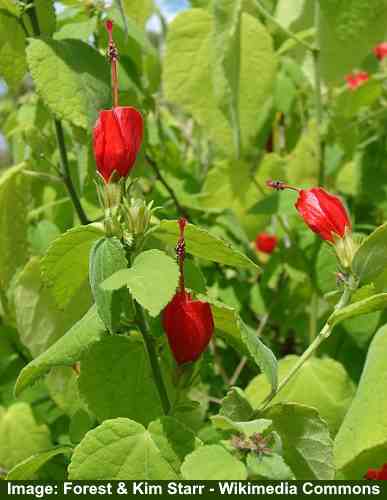
Turk’s cap is a small native shade loving red flowering shrub for central and south Texas
Turk’s cap is a native Texas shade plant that thrives in the central and southern regions of the state. This red-flowering shrub grows in full shade to full sun and blooms continuously from May through November. The attractive features of the shade-loving plant are its vibrant red hibiscus-like flowers and heart-shaped leaves.
In southern Texas, Turk’s cap has evergreen foliage and is tolerant of heat and drought. You can plant this small ornamental shrub in part to full shade as a foundation planting, specimen plant, or patio container shrub.
Other common names for Turk’s cap include Drummond’s wax mallow, Texas mallow, and sleeping hibiscus.
Size: 2 to 5 ft. (0.6 – 1.5 m) tall and wide.
Sun exposure: Part shade to full shade.
USDA growing zones: 7 to 10.
Related reading: The top shade plants for growing in Florida.
Pigeonberry (Rivina humilis)
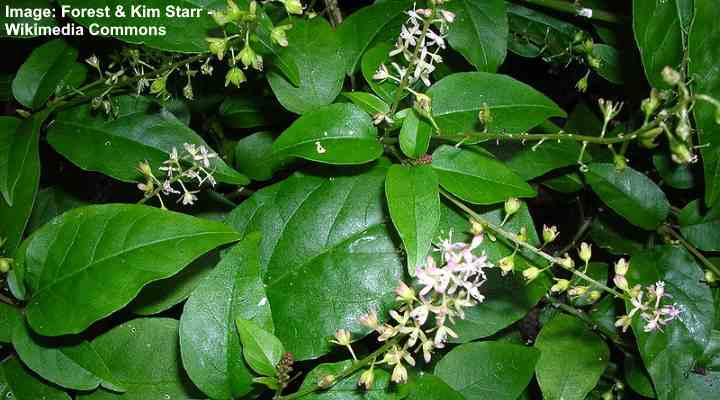
Pigeonberry is a perennial shade shrub for Texas landscapes and is small enough for tight spaces
Pigeonberry is a small flowering perennial shrub that thrives in shaded gardens in Texas. Also called bloodberry, this Texas native shade plant blooms throughout the year, producing dainty white or pink flowers. After blooming, the small flowers give way to vibrantly colored red berries. Additionally, the shrub has oblong, ovate leaves measuring 5” (13 cm) long.
Pigeonberry is perfect for dry landscapes in partial to full shade to grow as flowering ground cover if there is little sunlight. You can also plant this native small, fast-growing plant along a foundation line or fence or brighten a mixed bed.
Size: 3 to 5 ft. (1 – 1.5 m) tall and 1 to 3 ft. (0.3 – 1 m) wide.
Sun exposure: Part shade to complete shade.
USDA growing zones: 7 to 11.
Camellias

Camellia ’Winter’s Star’ (in the picture) thrives in dappled sun or partially shaded conditions
Several varieties of camellias are spectacular evergreen flowering shrubs that grow in all areas of Texas, apart from the Panhandle. These shade-tolerant shrubs have showy flowers with ruffled petals and double blooms. Camellias bloom in shades of pink, apricot, white and red.
Varieties of camellias that bloom in shaded Texan front or backyards include the following:
- Camellia’ Cinnamon Cindy’: For partial sun or full shade. The shrub has showy white flowers and grows 8 to 10 ft. (2.4 – 3 m) tall.
- Camellia’ Sparkling Burgundy’: This shade-loving shrub has peony-like pink flowers and grows 6 to 10 ft. (1.8 – 2.4 m) tall.
- Camellia’ Winter’s Star’: Cold-hardy from the Panhandle to the Gulf Coast, this flowering shrub has star-shaped pale pink flowers. It grows 4 to 6 ft. (1.2 – 1.8 m) tall.
Size: 4 to 10 ft. (1.2 – 3 m) tall and 2 to 8 ft. (0.6 – 2.4 m) wide, depending on the cultivar.
Sun exposure: Full sun to partial shade.
USDA growing zones: 7 to 9. However, some camellias are cold-hardy in zone 6.
Hydrangeas
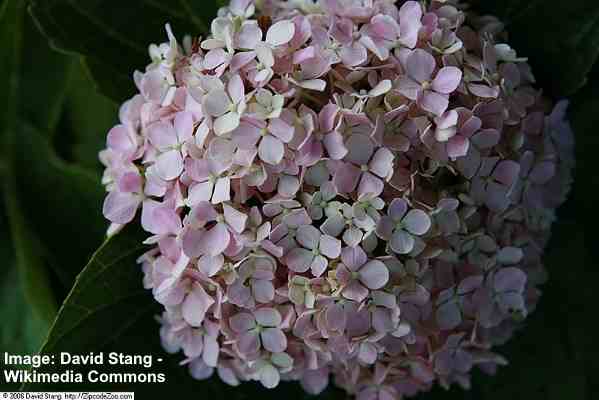
Hydrangea macrophylla ‘Big Daddy’ (in this image) is a shade loving shrub with pink flowers in alkaline soils and blue flowers in acidic soils
Hydrangeas are beautiful shrubs with large pompom or showy globular flowers. Many hydrangea varieties suit Texas’s climate and grow well in partial sun or shade. The hydrangea flowers can be blue, lilac, purple, red, white, pink or multi-colored, depending on the cultivar and soil type.
The shade-loving Hydrangea macrophylla ‘Big Daddy’ is a large shrub with reblooming mophead flowers that appear in early summer and persist until fall. This shrub has a rounded habit and can be used as an accent plant, flowering hedge, or foundation planting.
Size: 5 to 6 ft. (1.5 – 2.4 m) tall and wide.
Sun exposure: Partial sun to full shade.
USDA growing zones: 6 to 9.
Related reading: How to care for hydrangeas.
Impatiens
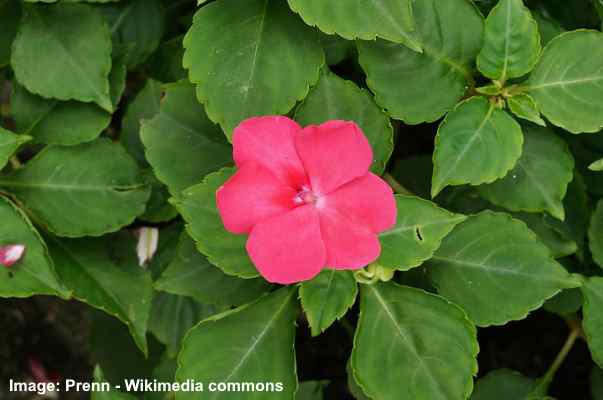
Impatiens walleriana (in the picture) is a shade-loving species of impatiens that thrive in filtered sunlight or dappled shaded areas
Impatiens are ground-hugging plants that thrive in the shade throughout all areas of Texas. Impatiens are known for their wonderful floral display and large colorful blooms. The low-growing plants have flowers measuring up to 2” (5 cm) across. The mound-forming perennials have long, dark green leaves and tolerate drought, heat, and shade.
In Northern Texas, impatiens grow as tender perennials or annuals. However, in Southern Texas, the fast-growing flowering plants bloom throughout the year.
Plant the flowers in window boxes, containers, or along a driveway. They are also shade-loving plants that grow as ground cover in Texas gardens that get little daily sunlight.
Size: 10” to 36” (25 – 90 cm) tall and 12” to 23” (30 – 60 cm) wide.
Sun exposure: Full sun to complete shade.
USDA growing zones: 2 to 11.
Pinwheel Jasmine (Gardenia jasminoides ‘Pinwheel’)
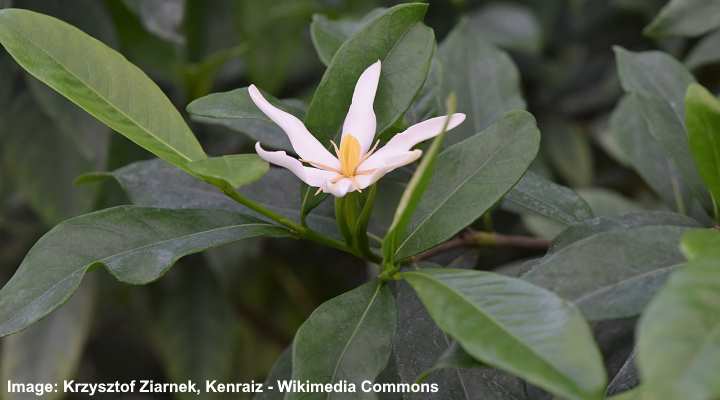
Pinwheel jasmine is an attractive flowering shrub for partial shade that is also suitable for all parts of Texas
Pinwheel Jasmine is a non-native plant in Texas that tolerates the shade exceptionally well. This jasmine shrub has evergreen foliage, fragrant white pinwheel flowers, and bushy growth. The evergreen shrub grows well throughout the Lone Star State, and its compact growth makes it perfect for landscaping small gardens.
Also called pinwheel cape jasmine, the lush evergreen foliage of glossy, leathery leaves makes the plant ideal as a screen or low-growing hedge. Additionally, you can plant the shrub along a foundation line or as a container plant for a deck area.
Size: 4 ft. (1.2 m) tall and wide.
Sun exposure: Full sun to light shade.
USDA growing zones: 6 to 11.
Low-Growing Shade Plants For Texas
Many low-growing plants are great for shady areas where other garden plants have difficulty growing. Some short plants are native to Texas, while others are not. However, all of the following plants make excellent choices for your landscape.
Cast Iron Plant (Aspidistra elatior)
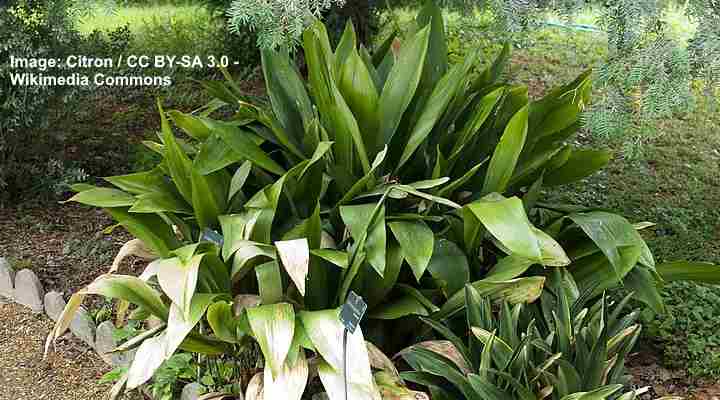
The cast iron plant is an evergreen plant for shaded Texas gardens with a clumping growth habit
The cast iron plant thrives in Central and Southern Texas and needs hardly any sunlight to thrive. The clumping evergreen plant is identified by its large lance-shaped leaves measuring 20” to 24” (50 – 60 cm) long and up to 6” (15 cm) wide. The plant grows as a mound and spreads, creating ground cover in the shade.
Size: 1 to 3 ft. (0.3 – 1 m) tall and wide.
Sun exposure: Full shade.
USDA growing zones: 7 to 11.
Monkey Grass (Liriope muscari)
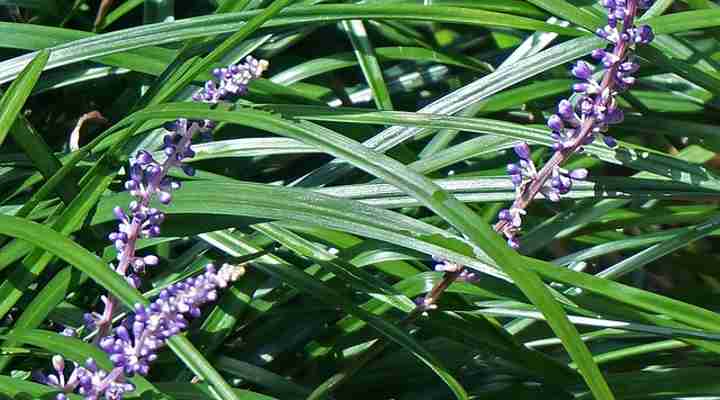
Because monkey grass thrives in the shade, it can be planted under shrubs and trees or in areas that are in constant shade
Also called lily turf, monkey grass is an evergreen perennial that loves the shade. The grass-like flowering plant is identified by its strap-like, slender green leaves, erect stems of lavender or pink flowering spikes, and spreading habit. Suitable for planting in all regions of Texas, money grass is a good turfgrass alternative.
Alternatively, you can plant monkey grass as pathway edging, ground cover for sun or shade, or create texture in front of trees and shrubs.
Size: 1 to 2 ft. (0.3 – 0.6 m) tall and wide.
Sun exposure: Full sun, partial shade, or full shade.
USDA growing zones: 5 to 10.
Periwinkle (Vinca)
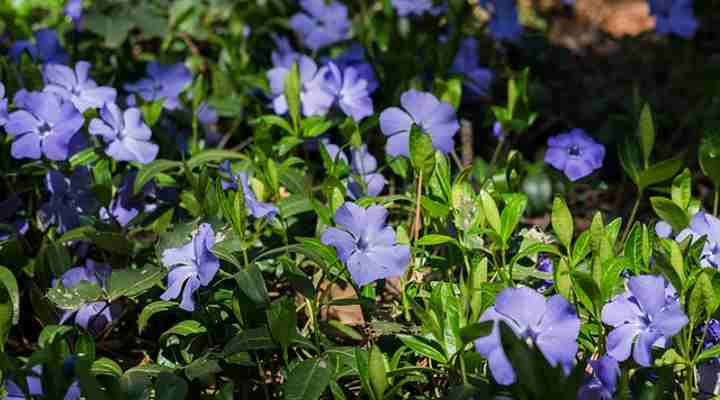
The trailing nature of periwinkle makes it ideal as a ground cover for shade in Texas landscaped gardens
Periwinkle plants are beautiful perennials to grow in the shade, whether you live in Amarillo, San Antonio, Dallas, Corpus Christi, or near the Mexican border. Periwinkles are mat-forming evergreen plants with large lilac or purple flowers. They bloom intermittently through summer until fall.
Apart from ground cover, periwinkle plants thrive in shady conditions on slopes, under shrubs, in north-facing window boxes, or in hanging baskets under a roof.
Size: 6” to 24” (15 – 60 cm) tall and 12” to 18” (30 – 45 cm) wide.
Sun exposure: Direct sunlight, partial shade, full shade.
USDA growing zones: 7 to 9.
Asiatic Jasmine (Trachelospermum asiaticum)
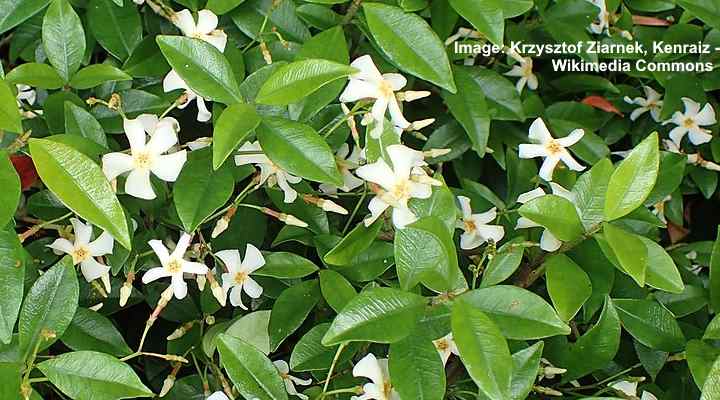
Asiatic jasmine is a low maintenance and easy care trailing flowering plant for partial shade
Asiatic jasmine is a shade-tolerant evergreen shrub or vine famed for its fragrant white flowers and lush foliage. This trailing shrubby vine has white jasmine-like, pinwheel white flowers, dark green oval leaves, and bronze-red fall colors in colder climates. Although it thrives in full sun, it also performs well in partial shade.
Asiatic jasmine is suitable for planting as a flowering ground cover or growing over a trellis, arbor, fence, or retaining wall. It also looks stunning with its white flowers and evergreen foliage cascading over a hanging basket.
Size: 0.5 to 20 ft. (0.15 – 6 m).
Sun exposure: Full sun or partial shade.
USDA growing zones: 7 to 11.
Variegated Ginger (Alpinia zerumbet ‘Variegata’)
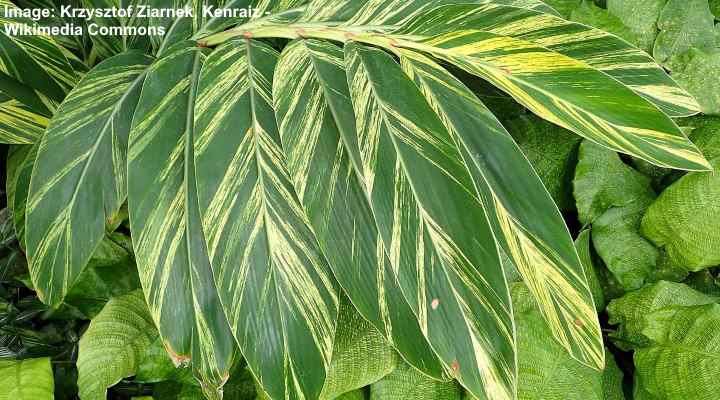
Variegated ginger is an ornamental ginger plant that tolerates partial shade and can be grown outdoors in south Texas
Variegated ginger is a tropical evergreen perennial that performs well in Southern Texas landscapes. The lush plant forms an upright clump of yellow and green variegated aromatic leaves and clusters of red, brown, or purple shell-like flowers blooming on arching stems. You can grow variegated ginger in containers to overwinter indoors in northern Texas.
Variegated ginger is suitable for growing as a front-of-house plant, specimen shrub, or as evergreen edging for a path or driveway.
Size: 3 to 10 ft. (1 – 3 m) tall and 2 to 4 ft. (0.6 – 1.2 m) wide.
Sun exposure: Full sun to part shade.
USDA growing zones: 8 to 11.
Tall Shade Plants For Texas
Many tall types of shade plants are available for Texas gardens to add height and color to a landscape.
Firespike (Odontonema cuspidatum)

Firespike is a flowering bush in south Texas that will bloom best in part sun to partial shade
Firespike is a tall, showy, drought-tolerant, evergreen shrub with erect flowering stems and clusters of bright red tubular flowers. This herbaceous clumping plant thrives in the warm regions of Texas. Apart from its 6-foot tall flowering spikes, the plant has showy green oval leaves with wavy margins.
Plant firespike in a shady frost-free Texas garden landscape if you want to add a splash of vibrant red colors. It adds color and texture to the back of flower beds or foundation plantings.
Size: 4 to 6 ft. (1.2 – 1.8 m) tall and 2 ft. (0.6 m) wide.
Sun exposure: Part sun to partial shade.
USDA growing zones: 8 to 11.
Heavenly Bamboo (Nandina domestica)
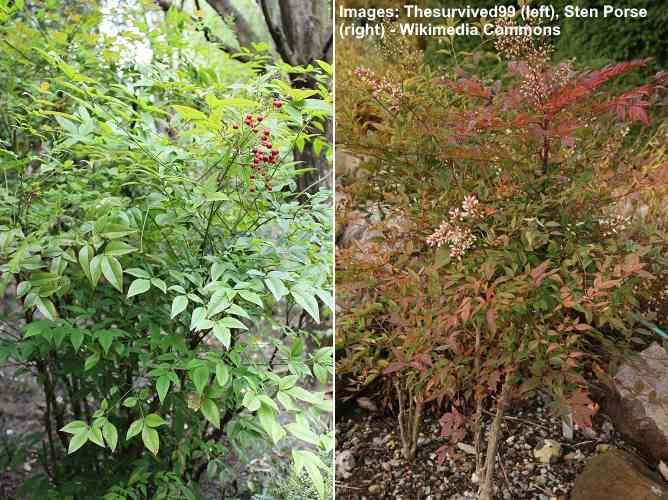
Nandina shrubs have upright growth habit and can be grown in partial shade
Heavenly bamboo is a tall flowering ornamental shrub that blooms well in partial shade. The attractive features of this evergreen plant are its purple and green foliage, a profusion of tiny white flowers, and bright red berries that persist during fall and winter. This adaptable plant provides a colorful height accent in a southern garden.
Use as a shrub border, back-of-bed accent plant, informal hedge, or foundation planting.
Size: 4 to 8 ft. (1.2 – 2.4 m) tall and 2 to 4 ft. (0.6 – 1.2 m) wide.
Sun exposure: Full sun or partial shade.
USDA growing zones: 6 to 9.
Related article: Nandina Plant Care and Growing Guide.
English Yew ‘David’ (Taxus baccata ‘David’)
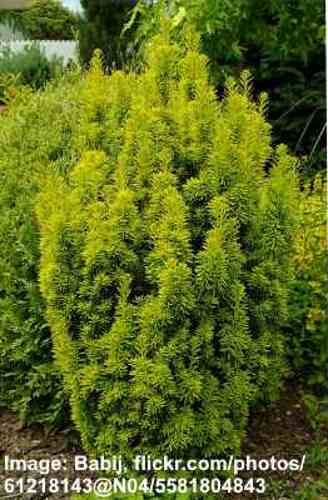
English yew ‘David’ is a shrub with columnar growth habit that can tolerate partial shaded conditions
English yew ‘David’ is a columnar evergreen shrub suitable for landscaping gardens in Central Texas. The densely-growing shrub has erect branches with golden green linear leaves. This heat-tolerant, shade-loving shrub creates lush, vertical height in small gardens to grow as a hedge, privacy screen, or specimen plant.
Size: 8 to 10 ft. (2.4 – 3 m) tall and 1 to 2 ft. (0.3 – 0.6 m) wide.
Sun exposure: Full sun to partial shade.
USDA growing zones: 7 and 8.
Shrubby Shade Plants For Texas
Many shrubs make excellent choices for Texas gardens because they perform well in hot, dry climates and don’t need a lot of sunshine to thrive.
Japanese Mahonia (Mahonia japonica)
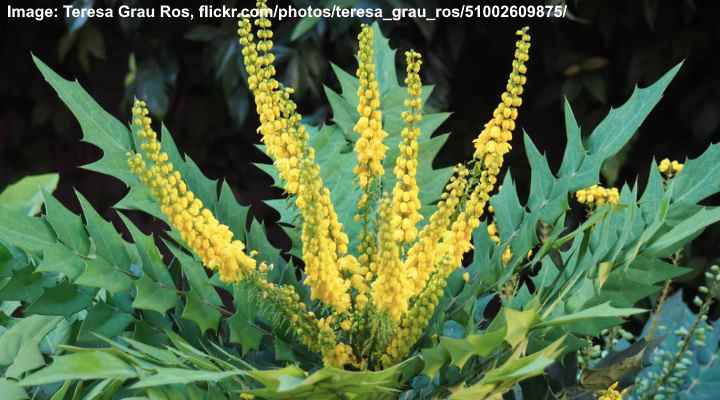
The evergreen Japanese mahonia shrub has yellow flower spikes and is suitable for landscaping partial or full shade areas
Japanese mahonia is a shrubby plant with lemon-yellow flowers, showy foliage, and grape-like bunches of blue-black berries. Thriving throughout most of Texas, this shrub performs best in part shade to full shade. It has striking spikes of bright yellow blooms contrasting with dark green spiky leaves.
Use Japanese mahonia as foundation plantings, a decorative specimen shrub, or to create an informal hedge.
Size: 8 to 10 ft. (2.4 – 3 m) tall and wide.
Sun exposure: Partial sun to full shade
USDA growing zones: 7 and 8.
Oakleaf Hydrangea (Hydrangea quercifolia)

Oakleaf hydrangea is an attractive white flowering shrub that grows well in partial shade
Oakleaf hydrangea is an excellent flowering, multi-stemmed native shrub to plant in a shady Texan garden landscape. The shrub has an irregular mounding habit. It is characterized by its large, deeply lobed leaves, large conical clusters of white flowers, and rich cinnamon-brown fall colors. This native Texas shrub performs well in dappled sunlight or partial shade in hot climates.
Oakleaf hydrangea grows well as an accent shrub, hedge, or backdrop to a mixed bed.
Size: 6 to 8 ft. (1.8 – 2.4 m) tall and wide.
Sun exposure: Filtered sunlight or full shade in hot climates.
USDA growing zones: 5 to 9.
Japanese Laurel (Aucuba japonica)

The spotted laurel is a great type of shrub for partial sun and shady areas with its decorative foliage
Japanese laurel is a non-native evergreen shrubby plant that is perfect for shady gardens in Texas. The eye-catching landscaping shrub has clusters of small purple flowers, leathery green leaves with yellow mottling, and bright red berries in the fall. These features give the rounded shrub four-season visual appeal in a southern backyard.
You can plant Japanese laurel as a foundation planting, hedge, or shrub borders. It also performs well in patios and containers.
Size: 6 to 10 ft. (1.8 – 3 m) tall and 5 to 9 ft. (1.5 – 2.7 m) wide.
Sun exposure: Partial shade to full shade.
USDA growing zones: 6 to 10.
Related articles:
